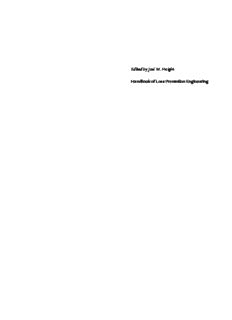
Handbook of Loss Prevention Engineering, Volume 1&2 PDF
Preview Handbook of Loss Prevention Engineering, Volume 1&2
EditedbyJoelM.Haight HandbookofLossPreventionEngineering RelatedTitles Reniers,G.L.L.,Zamparini,L.(eds.) Reniers,G.L.L. SecurityAspectsofUni-and Multi-Plant SafetyandSecurity Multimodal Hazmat Managementin theChemical Transportation Systems andProcessIndustries 2012 2010 Hardcover Hardcover ISBN:978-3-527-32990-8 ISBN:978-3-527-32551-1 Simonovic,S.P. CCPS SystemsApproachto Guidelines forProcessSafety Management ofDisasters Metrics MethodsandApplications 2009 Hardcover 2010 Hardcover ISBN:978-0-470-57212-2 ISBN:978-0-470-52809-9 Edited by Joel M. Haight Handbook of Loss Prevention Engineering Volume 1 TheEditor AllbookspublishedbyWiley-VCHare carefullyproduced.Nevertheless,authors, editors,andpublisherdonotwarrantthe JoelM.Haight,Ph.D.,P.E. informationcontainedinthesebooks, 1365PaxtonFarmRoad includingthisbook,tobefreeoferrors. Washington,PA15301 Readersareadvisedtokeepinmindthat USA statements,data,illustrations,procedural detailsorotheritemsmayinadvertentlybe inaccurate. LibraryofCongressCardNo.: appliedfor BritishLibraryCataloguing-in-Publication Data Acataloguerecordforthisbookisavailable fromtheBritishLibrary. Bibliographicinformationpublishedbythe DeutscheNationalbibliothek TheDeutscheNationalbibliothek liststhispublicationintheDeutsche Nationalbibliografie;detailedbibliographic dataareavailableontheInternetat <http://dnb.d-nb.de>. 2013Wiley-VCHVerlagGmbH&Co. KGaA,Boschstr.12,69469Weinheim, Germany Allrightsreserved(includingthoseof translationintootherlanguages).Nopart ofthisbookmaybereproducedinany form–byphotoprinting,microfilm,orany othermeans–nortransmittedortranslated intoamachinelanguagewithoutwritten permissionfromthepublishers.Registered names,trademarks,etc.usedinthisbook, evenwhennotspecificallymarkedassuch, arenottobeconsideredunprotectedbylaw. PrintISBN:978-3-527-32995-3 ePDFISBN:978-3-527-65067-5 ePubISBN:978-3-527-65066-8 mobiISBN:978-3-527-65065-1 oBookISBN:978-3-527-65064-4 CoverDesign Grafik-DesignSchulz, Fußgo¨nheim Typesetting LaserwordsPrivateLimited, Chennai,India PrintingandBinding MarkonoPrintMedia PteLtd,Singapore Printedonacid-freepaper V ContentstoVolume 1 Preface XVII ListofContributors XIX PartI EngineeringManagementforLossPreventionEngineering 1 1 ManagementSystems – LossPreventionEngineeringProgramsand Policy 3 ShakirudeenShakioye 1.1 Introduction – UnderstandingtheNeedforManagement Systems 3 1.2 ManagementSystems – Definitions 6 1.3 LossPreventionEngineering – Considerations 7 1.4 ManagementSystems – LossPreventionEngineering 9 1.4.1 LeadershipCommitment 10 1.4.2 VisionandObjectives 10 1.4.3 Resources/Policy/Processes/Procedure/Regulations 11 1.4.3.1 Resources 12 1.4.3.2 Policy 14 1.4.3.3 RegulatoryConsideration 14 1.4.3.4 Processes 15 1.4.3.5 HESProcessesApproachandStructure 15 1.4.4 BusinessPlanning(HES) 18 1.4.5 Implementation 20 1.4.6 EvaluationofManagementSystemforImprovement 21 1.4.7 PeriodicCorporationAudit 21 1.4.8 EnterpriseAuditPlan 21 1.4.9 AuditsLevelsandContinuousImprovement 22 Appendix1.A:BCN – NSHESampleDrugandAlcohol Policy 24 Appendix1.B:Behavior-BasedSafetySupportingTool 26 Appendix1.C:SampleInternalSimpleInspectionChecklist 27 References 28 VI Contents 2 ResourceAllocationandEffectivenessMeasuresforLossPrevention 31 SamuelA.Oyewole 2.1 Introduction 31 2.2 WhatIsLossPrevention/SafetyandHealthIntervention? 32 2.3 HistoricalPerspectiveofResourceAllocationforLoss Prevention 33 2.4 LossPrevention/SafetyandHealthInterventionEffectiveness Evaluation 36 2.5 ImportanceofMultipleFactorsinLossPrevention 37 2.6 ResearchMethodologyinResourceAllocationforLoss Prevention 38 2.7 ExperimentalMethod 39 2.8 AnalysisandResults 39 2.9 Conclusion 48 References 50 3 EngineeringSystemsandEngineeringEconomicsofLossPrevention 53 JoelM.Haight 3.1 Introduction 53 3.2 CostofInjuries 55 3.3 ReturnonInvestmentVersusCostSavingsVersusProductivity Savings 56 3.4 EngineeringEconomics 57 3.5 EngineeringEconomicDecision-Making 59 3.6 NetPresentValueComparison(EquipmentReplacement) 59 3.6.1 FinalResultandDecision 64 3.6.2 AcceptorRejectDecisionforaSimpleInvestmentBasedonRateof Return 64 3.7 PaybackPeriodComparison 65 3.8 FinancialConsiderationsofaLossPreventionEngineering Project 66 3.8.1 ProjectBudget 66 3.9 Conclusion 69 References 69 4 SafetyManagementandCulture 71 BrianW.TinkandBrianA.Tink 4.1 WhatIsOrganizationalCulture? 71 4.2 HowDoesCultureForm? 74 4.3 WhyIsItGoodBusinesstoImproveYourCompany’s Culture? 77 4.4 MeasuringCulture 79 4.5 HowtoBringAboutChangesinCulture 82 References 86 Contents VII 5 LeadershipandLossPreventionEngineering:CreatingConditionstoGet BeyondCompliancetoHighPerformance 89 MicheleLindsay 5.1 Introduction 89 5.2 ManagementTheories 92 5.2.1 ScientificManagementTheory 92 5.2.2 TheLinkBetweenMotivationinIndividualsandManagement Theories 93 5.2.3 MotivationTheoriesIntegratedintoManagementTheories 94 5.2.3.1 AutonomyfortheIndividual 96 5.2.3.2 CompetencefortheIndividual 97 5.2.3.3 RelatednessforIndividual 98 5.3 MovingBeyondMechanisticManagement 99 5.4 HumanisticOrganizations 99 5.4.1 AutonomyinOrganizations 101 5.4.2 CompetenceinOrganizations 102 5.4.3 RelatednessinOrganizations 105 5.5 CaseStudiesofHumanisticManagement 107 References 110 PartII DesignandAnalysisofProtectiveSystems – GeneralLoss PreventionEngineering 113 6 GeneralLossPreventionEngineeringPrograms – IncludingFireLoss Control 115 JefferyRobinson 6.1 Background 115 6.2 Introduction 116 6.3 ElementsofaFireLossControlProgram 116 6.3.1 PolicyStatement 116 6.3.2 RolesandResponsibilities 116 6.4 FirePreventionControls 118 6.4.1 DesignConsiderations – SelectionofMaterialsfor Construction 118 6.4.2 FirePreventionControls 121 6.4.3 PreventingLosses – SafeHotWorkPractices 122 6.4.4 IdentifyingElectricalHazards 126 6.4.5 ControllingLosses 127 6.4.6 FireImpairmentManagement 128 6.4.6.1 PlannedImpairments 129 6.4.6.2 UnplannedImpairments 131 6.4.6.3 RestorationofImpairedSystems 131 6.4.7 PlantEmergencyOrganization(PEO) 131 6.4.7.1 FirefightingTeamSelection 132 6.4.7.2 SalvageandRestoration 133 VIII Contents 6.4.7.3 Training 133 6.4.7.4 WrittenPEOPlan 134 AppendixA.LossPreventionSurvey 135 References 140 7 Permit-to-WorkSystems 141 JohnW.Mroszczyk 7.1 Introduction 141 7.2 ThePermit-to-WorkProcess 141 7.3 RegulationsandStandards 145 7.4 HotWork 145 7.5 ConfinedSpace 149 7.6 LiveLineElectricalWork 151 References 156 RecommendedReading 156 8 ExcavationandTrenching 159 MichaelW.Hayslip 8.1 Introduction 159 8.2 HazardIdentificationandFederalOSHARegulation 162 8.3 SoilTypes 166 8.3.1 Loess 168 8.3.2 ExpansiveSoils 169 8.3.3 OrganicSoilsandPeat 170 8.3.4 ColluviumandTalus 170 8.3.5 ShalesandDegradableMaterials 171 8.3.6 CalicheandCementedSands 171 8.3.7 SensitiveClaysandSands 172 8.4 BasicSoilMechanicsTheory 172 8.5 TestingandSoilClassificationSystems 176 8.5.1 StandardPenetrationTest(SPT) 181 8.5.1.1 ProceduresWhichMayAffecttheMeasuredNValues 182 8.5.2 ConePenetrometer 183 8.5.3 OtherTypesofShearTests(Laboratory) 183 8.6 ProtectiveSystems 185 8.6.1 SlopeConfigurations(OSHA29CFR1926) 186 8.6.1.1 ExcavationsMadeinTypeASoil 186 8.6.1.2 ExcavationsMadeinTypeBSoil(OSHA29CFR1926) 189 8.6.1.3 ExcavationsMadeinTypeCSoil(OSHA29CFR1926) 190 8.6.2 TimberShoring – AppendixCtoOSHA29CFR1926.652 191 8.6.3 AluminumHydraulicShoring – AppendixDtoOSHA29CFR 1926.652 191 8.6.4 AlternativestoTimberShoring – AppendixEofOSHA29CFR 1926.652 192 Contents IX Glossary(TakeninPartfromStandardHandbookforCivilEngineers (Ricketts,Loftin,andMerritt,2003)andOSHA29CFR1926(OSHA, 2012b)) 192 References 199 9 MachineSafeguarding 201 JohnW.Mroszczyk 9.1 Introduction 201 9.2 RegulationsandStandards 202 9.3 MachineMotionHazards 203 9.4 HumanFactorAspectsofMachineGuarding 206 9.5 MachineSafeguardingMethodology 207 9.6 BasicMachineGuardingPrinciples 212 9.7 TypesofMachineSafeguarding 213 9.8 MachineControls 220 9.9 ResponsibilitiesoftheMachineBuilder 223 9.10 MechanicalPowerPresses 224 9.11 PowerPressBrakes 224 9.12 Conveyors 225 9.13 Roll-FormingandRoll-BendingMachines 225 9.14 ShearingMachines 225 9.15 LaserMachining 226 9.16 Robots 227 9.17 Conclusion 228 References 228 FurtherReading 229 10 BoilersandPressureVessels:aBriefLookatGeneralSafeguards 231 PatrickFortune 10.1 Water 231 10.2 Safeguards 234 10.3 Codes,Regulations,andTraining 235 10.4 TypesofBoilers 238 10.5 OperatingConsiderations 240 10.6 BoilerFeedWater 244 10.7 ChemicalHandling 247 10.8 Steam 251 10.9 SpecialConsiderationsforPressureVessels 255 10.10 FireDetectionandControl 256 10.11 IncidentInvestigation 257 10.12 ClosingThoughts 258 References 259 X Contents 11 WeldingandCutting 261 JefferyS.Haight 11.1 Introduction 261 11.2 BasicEquipmentforWeldingComfortablyandSafely 264 11.2.1 EyeProtection 264 11.2.2 HandProtection 265 11.2.3 BodyProtection 266 11.2.4 RespiratoryProtection 266 11.3 TheWeldingProcess 267 11.3.1 GasMetalArcWelding(MIG) 268 11.3.2 TungstenInertGasWelding(TIG) 270 11.4 Cutting 272 11.4.1 Safety 273 11.4.2 PlasmaCutting 274 11.5 Conclusion 276 References 276 12 PowerTools 277 WarrenK.Brown 12.1 Introduction 277 12.2 Guards 281 12.3 SafetySwitches 282 12.4 ElectricTools 282 12.5 PoweredAbrasiveWheelTools 283 12.6 LiquidFuelTools 283 12.7 PneumaticTools 284 12.8 HydraulicPowerTools 284 12.8.1 PortableHand-HeldCircularSaw 285 12.8.2 PortableAngleGrinder 287 12.8.3 PortableDrill/Driver 289 12.8.4 PortableSanders 291 12.8.5 ReciprocatingSaws 292 12.8.6 ImpactWrench – AirandElectric 294 12.8.7 Jigsaw/SaberSaw 295 12.8.8 MultifunctionPowerTool 296 12.8.9 HeatGun 297 12.8.10 PortableAirCompressor 298 12.8.11 ShopVacuum 300 12.9 Conclusion 301 References 301 13 PersonalProtectiveEquipment 303 ChristopherM.Stroz 13.1 Introduction 303 13.2 GeneralSelection 304
Description: